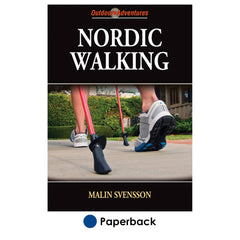Ten technique tips for Nordic walking
This is an excerpt from Nordic Walking by Malin Svensson.
Perfect walking performance
Nordic walking is an enhancement of regular walking. A person can go from point A to point B, but how efficient and how pain free is that walk? When the foot lands, it has so many options to move (or not move) due to muscle strength and flexibility in the whole body. When all the body weight is applied on the poor foot seconds later, the ankle joint had better get all the support it needs from the correct muscles to carry the weight.
Practice one step at a time while walking around indoors or outdoors. See how it feels, and be aware of it while out for a stroll.
- Heel Strikes First. When landing with the foot, make sure the heel lands first, more specifically with the center of the heel first. Walk around and see if it feels as though it is being done the right way. Focus on one foot at a time.
- Rock and Roll Like a Rocker. After landing with the heel, continue to roll onto the rest of the foot. Practice this rolling movement by first standing still: Rock back and forth from heel to toes like a rocking chair. It is fairly easy to hear feet that don't roll, especially with shoes on when going downhill. There is a slapping sound. Feet that roll are almost soundless. Try it and listen. Next time you have shoes on while walking down a hill, listen and decide whether your feet are slapping or are quiet. If sore shins are common, the slapping of the feet could be one cause.
- Heel Comes Off the Ground. While rolling onto the ball of the foot (base of the toes), the heel comes off the ground. Now walk around and feel the heel coming off. Concentrate on one foot only.
- Push Off With the Ball of the Foot. Then push the ball of the foot down and back into the ground. This push-off action propels the body forward. Walk around and feel how to push off with the base of the toes.
- Activate the Buttocks. At the same time the ball of the foot is pushed on, the bottom of the buttuck is activated. That is singular. Tighten only one buttock. Feel the connection between push-off action of the ball of the foot and the activation of the buttock of the same leg.
- Fall (Lean) Forward. While walking, make sure to lean forward as one unit. It feels almost as like the body is falling forward. The weight should be on the balls of the feet. Always keep that core activated in a neutral pelvic position to avoid any bending in the waist or rounding of the back while leaning forward. Walk around and see how it feels to lean forward as one unit. Does it feel as if speed is increasing? If so, this is correct.
- Arm Meets Opposite Leg. Start walking. After a few steps, glance down to see the left arm swinging forward. Next, observe what foot lands at the same time. Yes, the right foot lands at the same time the left arm swings forward. Basically, left arm meets right leg, and right arm meets left leg. This is the natural walking rhythm, and most people don't even think about it-it just happens naturally.
- Use an Even and Straight Arm Swing. When the arm and leg rhythm is mastered, make sure the arm swing is even. In other words, swing the arm as much forward as backward. This is hard to see on yourself unless somebody videotapes you from the side. One solution is to stand sideways in front of a mirror. Swing one arm and see if there is an even swing or if it mainly swings forward. Try to correct it and walk around with this awareness.
- Slightly Twist the Rib Cage. Stand still and place the hands around the rib cage, just below the chest. Keep the head and hips straight while softly turning the rib cage from right to left. Feel the twist (rotation). Focus on the solar plexus, where the axis of the rotation takes place. Try maintaining this twisting movement while releasing the hands. Start walking and add this slight rotation to the walk. Don't slow down, but keep a regular pace. A slight torso rotation to the left naturally moves the right arm forward. That also means that the opposite leg, in this case the left one, moves forward. Remember step 7: Arm meets opposite leg.
- Walking in Balance. It is very important to keep the core activated and the shoulder blades stabilized during the slight rotation. Divide the body into two parts: upper and lower. Their meeting place is in the solar plexus. Initiating movement from the inside from this meeting place, creates an efficient way for the body to maintain balance while walking.
This is an excerpt from Nordic Walking.
More Excerpts From Nordic Walking

Get the latest insights with regular newsletters, plus periodic product information and special insider offers.
JOIN NOW


